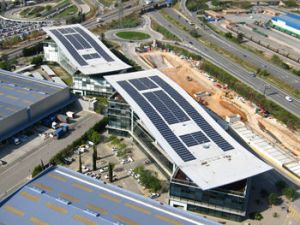Apr 28 2010
Homeowners who wanted to produce energy by capturing the sun's rays through solar panels on their roofs used to have to put up with ugly add-ons to their houses in order to help save the planet.
 Evalon Solar
Evalon Solar
But now there is no need for green buildings to be either expensive or an eyesore, says a Spanish-German partnership, which has developed a virtually invisible solar film for an accessible price in a EUREKA project.
"You don't see the film at all – it's marvellous," says Francisco Ruiz Caballero, General Manager and Head of R&D projects at Intemper Espanola, the Spanish partner which led EUREKA project Fotointegral. "It's integrated into the building rather than superimposed on it."
Much solar energy technology uses rigid crystal silicon panels. Installing them on homes or offices usually involves placing a mechanical frame on the building – and that usually comes on top of rooftop waterproofing and insulation. Ruiz started to wonder if four or five separate products on a roof were really necessary and whether they couldn't be combined into one multi-purpose product, made from flexible silicon cells.
One of Intemper's suppliers was bought by a German company with an industry reputation for waterproofing flat roofs, which made it a clear candidate to partner with Ruiz's Intemper in researching the new product. The company agreed to join the R&D with EUREKA backing.
Although some solar panelling did use amorphous silicon cells, they tended to be too expensive and had a reputation for being less effective than the crystal silicon panelling. Intemper and its partner had to make their flexible film thin enough to not jut out and spoil the sharp lines on stylishly designed roofs – and then they had to ensure the solar power it generated could compete with the power output from bulky panelling.
SOLAR SAMPLING
The German company created sophisticated performance tables to measure the quality of the test combinations of silicon cells the team developed. The researchers needed to know how thin the panelling could be, how the solar cells reacted to sunlight, how well they resisted the elements like wind and rain and how much energy they lost at different angles, if the cells were not all totally exposed to the sun. "One of the hard parts was testing the product on all kinds of inclinations," says Ruiz.
Meticulous trials and analysis of the databases eventually paid off – the team found a film developed which was just 6mm thick could even be used on vertical surfaces and would lose only about 8 percent of the energy captured from the sun. The pair called this all-in-one roof insulation, waterproofing and solar-panelling Evalon Solar.
Intemper and the other company participating in the project are already selling it in their home markets and have their sights set on expansion as all countries seek to reduce their carbon dioxide emissions and increase the energy generated through renewables. Intemper has signed contracts in Portugal and is now looking at Latin America, starting with Chile and Colombia.
A DESIGNER'S DREAM
Evalon Solar is a hit, particularly with architects looking to include solar panelling on buildings without cluttering up simple roofs or spoiling unusual or effective shapes. "We've got another 46 architects coming to look round our site tomorrow," says Ruiz.
"Architects tell us it looks even better when they see it for themselves on buildings than it does in our photographs."
The new product happily increased the pair's markets, giving them an edge as the industry battled the global downturn and a change in solar subsidies in Spain. "We would have done even better without the crisis and the regulation, but we've managed to get a bigger slice of a smaller cake," says Ruiz.
Intemper has sold Evalon Solar to customers, large and small, for residential and business premises. Although now the product is a clear winner, developing a technology which was marginal in the industry looked risky back at the start of the project in early 2006: the vast majority of photovoltaic generators sold all over the world were made from crystal silicon and only a tiny minority from amorphous silicon.
"EUREKA helped us to make the decision to pursue this because the EUREKA seal gave us a certain financial peace of mind," says Ruiz. Evalon Solar's success is starting to change the industry. "Other similar products to ours have come. Unfortunately, yes, when you're successful, people want to copy!"
Source: http://www.intemper.com/